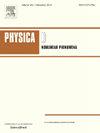三层粘性流体系统界面耦合研究
IF 2.7
3区 数学
Q1 MATHEMATICS, APPLIED
引用次数: 0
摘要
采用线性稳定性分析方法,研究了在重力场作用下粘度和表面张力对三种非混相不可压缩牛顿流体叠加体系的影响。特征值问题以一般的方式表述,以突出对给定物理参数集的解析解和其他要确定的数值解。用一个等于中间层厚度与扰动波数乘积的耦合参数来分析这些解的行为。当该参数足够大时,将对三层流体系统的研究简化为对两层流体子系统的研究。对于一个三层流体系统,在底部有一个重力不稳定界面,在顶部有一个重力稳定界面,分别确定了解,以突出瑞利-泰勒不稳定性和重力波以及这两种现象之间的耦合。通过求解初值问题得到物理量的时间演化。为此,在两个界面处施加单模扰动作为初始条件。使用内部代码进行直接数值模拟,由界面位置和流体速度初始化,使我们能够比较它们的时间演变。结果与理论非常吻合,直到一个界面的振幅变得过大,与流动的非线性效应相同。根据最初哪种溶液对流动的影响最大,可以观察到三种主要的状态。本文章由计算机程序翻译,如有差异,请以英文原文为准。
Study of interface coupling in three-layer viscous fluid systems
Linear stability analysis is performed to study the effect of viscosity and surface tension on a system composed of three superimposed immiscible incompressible Newtonian fluids under the gravity field. The eigenvalue problem is formulated in a general way to highlight an analytical solution and other solutions to be determined numerically for a given set of physical parameters. The behaviour of these solutions is analysed using a coupling parameter equal to the product between the thickness of the middle layer and the wave number of the disturbance. When this parameter is large enough, the study of this three-layer fluid system is reduced to the study of two-layer fluid subsystems. The solutions were determined for a three-layer fluid system of interest with a gravitationally unstable interface at the bottom and a gravitationally stable interface at the top to highlight respectively the Rayleigh–Taylor instability and a gravity wave as well as the coupling between these two phenomena. The temporal evolution of the physical quantities is obtained by solving the initial value problem. For this purpose, single-mode disturbances at the two interfaces are imposed as initial conditions. Direct numerical simulations performed with an in-house code initialized by the interface positions and the fluid velocities allow us to compare their temporal evolutions. Results show an excellent agreement with the theory until the amplitude of one interface becomes too large in the same way as the nonlinear effects of the flow. Three main regimes are observed depending on which solutions initially influence the flow the most.
求助全文
通过发布文献求助,成功后即可免费获取论文全文。
去求助
来源期刊

Physica D: Nonlinear Phenomena
物理-物理:数学物理
CiteScore
7.30
自引率
7.50%
发文量
213
审稿时长
65 days
期刊介绍:
Physica D (Nonlinear Phenomena) publishes research and review articles reporting on experimental and theoretical works, techniques and ideas that advance the understanding of nonlinear phenomena. Topics encompass wave motion in physical, chemical and biological systems; physical or biological phenomena governed by nonlinear field equations, including hydrodynamics and turbulence; pattern formation and cooperative phenomena; instability, bifurcations, chaos, and space-time disorder; integrable/Hamiltonian systems; asymptotic analysis and, more generally, mathematical methods for nonlinear systems.
 求助内容:
求助内容: 应助结果提醒方式:
应助结果提醒方式:


